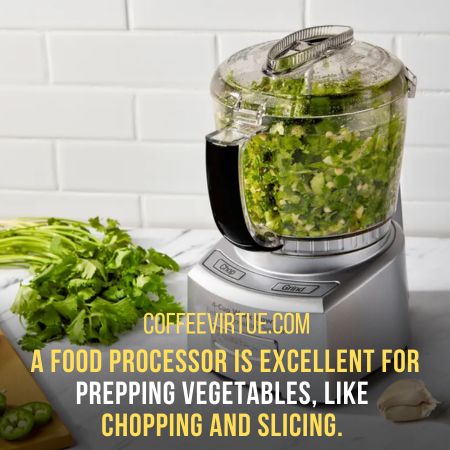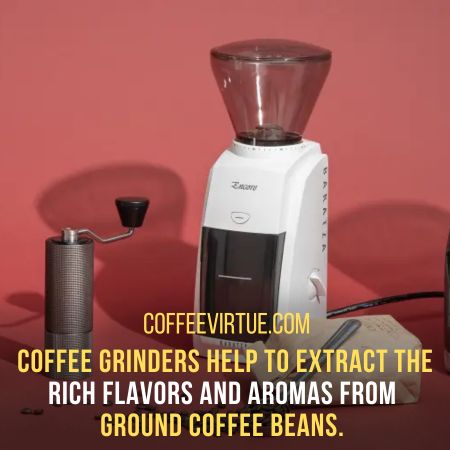Food processors vs. coffee grinders. Both are two of the most popular kitchen appliances. Which one is right for you depends on what you plan to use them for.
What Will I learn
In this article, we’ll compare the advantages and disadvantages of each appliance. So you can decide which one is best for your needs.
Food Processor Vs. Coffee Grinder
When it comes to kitchen appliances, one of the biggest decisions you can make is choosing between a food processor and a coffee grinder.
Both pieces of equipment are essential for making delicious meals and beverages. But both serve very different purposes.
Food processors are great for grinding, chopping, blending, and mixing ingredients. They come in various sizes, so you can choose one that fits your needs.
Some food processors even have attachments. It allows you to make doughs and purees with ease.
Food processors are great for making pesto sauces, hummus, salsas, and other dishes. It requires a lot of chopping and blending.

Coffee grinders are designed for grinding coffee beans into a consistent texture. They usually come with adjustable settings.
It lets you choose coarse to fine grinds for different coffee brews. Coffee grinders can also grind spices, nuts, and seeds.
It makes them incredibly versatile. In the end, it all comes down to personal preference.
Go with a food processor if you want more flexibility when making meals and drinks. But if you only need to grind small ingredients at a time.
A coffee grinder is the way to go if it wants to make coffee. Keep in mind that you can always purchase both.
Each appliance has its advantages and disadvantages.
Difference Between Food Processor Vs. Coffee Grinder
Food processors and coffee grinders are both incredibly useful kitchen tools. They have some key differences that affect how you use them.
Here’s a closer look at the two to decide which is best for your needs.
1. Size:
A food processor is much larger than a coffee grinder. Generally, taking up more counter space and requiring more storage space.
The bowl of a food processor is larger, having a capacity of around 2-3 quarts.
While most coffee grinders are much smaller and have a minimum capacity of 1 cup.
2. Functionality:
Food processors are designed to handle heavier tasks than coffee grinders. They can help to grind dry ingredients like spices, grains, and nuts.
These food processors can also puree ingredients and make dough for baking. Coffee grinder hands are meant for grinding coffee beans into fine particles.
3. Power:
Food processors usually have more powerful motors than coffee grinders.
A food processor’s motor is between 500-1000 watts. In contrast, a typical coffee grinder has a motor of around 300-500 watts.
This makes food processors better at handling, like chopping and grinding harder ingredients.
Coffee grinders are best used for grinding small amounts of softer ingredients.
4. Cost:
Food processors tend to be more expensive than coffee grinders. It is due to their larger size, more powerful motors, and greater functionality.
Prices can range from around $50 to $400, depending on the features and brand.
On the other hand, coffee grinders are usually quite affordable and can cost as little as $20.
It’s important to consider your needs when choosing between a food processor and a coffee grinder.
A food processor is the better option if you want an all-purpose tool that can handle various tasks.
But if you need something to grind coffee beans, a coffee grinder will do the job without breaking the bank.
A Food Processor
A food processor is an essential kitchen appliance for quickly preparing ingredients.
It’s perfect for chopping, slicing, shredding, kneading dough, pureeing food, and much more.
With a powerful motor and multiple attachments, it can handle almost any task in the kitchen.
A food processor is invaluable if you’re making mashed potatoes or pizza dough.
It can save you time and effort, ensuring food preparation is always a breeze.
You can make nut butter or grind grains into flour for baking with the right model.
Food processors come in a variety of sizes and price ranges. So there’s something to fit almost any budget or kitchen space.
When shopping for one, consider how often you’ll use it and what tasks you want it to do.
A food processor can become a valuable part of your kitchen arsenal with the right model.
5 USES OF Food Processor
Using a food processor can make cooking so much easier. A food processor is a great kitchen tool.
It helps you chop, slice, shred, and mix ingredients quickly and efficiently.
With its versatile capabilities, the food processor has become an integral part of the kitchen.
1. Prepping Vegetables:
A food processor is excellent for prepping vegetables, like chopping and slicing potatoes.

Use the slicing disc to get paper-thin slices of cucumbers and carrots for salads. A food processor can even help you make homemade mashed potatoes easily.
2. Grating Cheese:
If you’ve ever tried grating a block of cheese by hand, you know how tedious it can be.
However, grating cheese is much quicker and easier with a food processor. Place the cheese in the bowl of the processor.
Use the grater attachment to create perfect shreds every time.
3. Making Dough:
Not only can a food processor help you make dough quickly, but it can also improve the texture of your dough.
The blades in the food processor help mix and knead the ingredients evenly. It results in a light and fluffy finished product.
4. Blending Sauces And Dips:
A food processor makes sauces like pesto, hummus, and guacamole.
Place all the ingredients in the processor. Blend until you reach your desired consistency.
Add some liquid for a creamier dip or sauce to help thin it out.
5. Chopping Nuts:
If you’re looking for a quick way to chop nuts for baking or garnishing dishes. A food processor is the perfect tool for the job.
Place your nuts in the bowl and attach the chopping blade. Pulse several times to get chopped nuts, even in size and texture.
With these tips, you can make the most out of your food processor.
Whether prepping vegetables or creating sauces and dips, a food processor will make any task easier.
5 ADVANTAGES OF USING A FOOD PROCESSOR
Food processors come with numerous advantages. These advantages make them more reliable.
Here are some of the common advantages of a food processor:
1. Versatility:
A food processor can do the work of many kitchen tools. Also, it can work for appliances like choppers, mixers, blenders, and grinders.
It is perfect for slicing, mincing, grating, pureeing, and kneading dough. It can also make smoothies, nut butter, sauces, and dips.
2. Efficiency:
A food processor helps speed up kitchen tasks with its powerful motor and sharp blades.
These blades quickly chop, slice or grind ingredients. This can save a lot of time when preparing meals.
3. Variety of Blades:
Food processors come with several blades, such as slicing and grating discs.
This allows a wide range of tasks to be completed with one appliance.
4. Ease of Cleaning:
Most food processors come with removable blades. It makes it easy to clean the appliance after use.
They also usually have a dishwasher-safe bowl, making cleaning even easier.
5. Cost Savings:
Food processors are usually cheaper than other kitchen appliances like blenders and mixers.
They also save money by helping to reduce food waste.
Coffee Grinder
Coffee grinders are essential tools for making the perfect cup of coffee. They help to extract the rich flavors and aromas from freshly ground coffee beans.
It allows you to enjoy a fuller flavor profile in every cup. Whether you’re an at-home or professional barista working in a cafe.
A quality grinder is essential for getting the best result from your coffee beans.
There are many types of coffee grinders with different features and benefits. Burr grinders are among the most popular.
They offer a consistent grind size and can produce both espresso-level. You can have fine grounds or coarser French press grounds.
3 Tips For Using A Coffee Grinder
Coffee grinders are a great way to make the perfect cup of coffee. But how do you use one correctly? Here are some simple tips for using a coffee grinder.
1. Grind Size:
When selecting the grind size, it is important to consider your brewing method. A finer grind will produce a stronger flavor with espresso machines.
A coarser grind is better suited for French presses and drip makers.
Adjust the grind size according to your preferred brewing method to get the best results.
2. Cleaning:
It’s important to clean your coffee grinder regularly. It runs smoothly and prevents any buildup of coffee oils or grounds.
After each use, remove any leftover grounds from the grinder bowl. Brush out the blades with a soft-bristled brush.
You should use a damp cloth or paper towel to wipe down the outside of your machine.
3. Storage:
Coffee grinders should be stored in a cool, dry place away from direct sunlight or excessive heat.
Additionally, if you will not use your grinder for an extended period.
It is best to unplug it and empty the bowl so no moisture or condensation can accumulate in the machine.
These simple tips will help you get the most out of your coffee grinder. With the right grind size, regular cleaning.
4 Advantages Of Using A Coffee Grinder
A coffee grinder is a great tool when you are serious about brewing perfect coffee.
Whether you prefer drip or espresso, the right grinder can make all the difference in the flavor of your cup. Here are some advantages of using a coffee grinder:
1. Freshness:
Using a coffee grinder ensures that your beans remain as fresh as possible. It allows you to get the most flavor out of your coffee.
Whole beans retain their flavor and aroma better than pre-ground coffee.
So grinding your beans will always be the best option if you’re looking for optimal taste.
2. Precision:
By using a coffee grinder, you can achieve a precise grind size. It is perfectly tailored to your preferred coffee-making method.
This can help you dial in the perfect flavor for whatever kind of coffee you’re making.
3. Cost:
Using a grinder can also save you money in the long run. Pre-ground coffee can be expensive and not always of the best quality.
Grinding beans gives you much more control over the quality and price of the coffee.
4. Convenience:
Grinding your beans is also a lot more convenient than buying pre-ground coffee. Rather than having to make multiple trips to the store.

You can grind your beans as needed and always have freshly ground coffee on hand.
Investing in a good coffee grinder can take your coffee-making skills to the next level. You can enjoy superior-tasting coffee every time.
With so many advantages, it’s no wonder home baristas turn to a coffee grinder for their daily brew.
CONCLUSION:
When you choose between a food processor and a coffee grinder, think about what you’re trying to make.
Food processors take up more room than coffee grinders. They have a lot of countertop space they might not be the best choice for you.
They’re more expensive than coffee grinders. A coffee grinder might be the better option if you don’t cook often or are on a tighter budget.